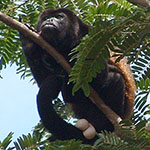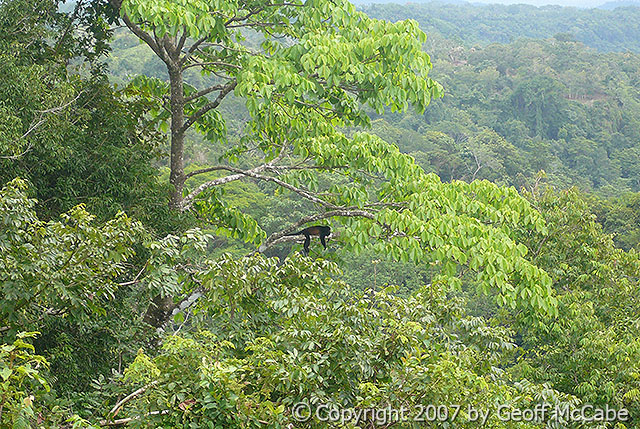- Home
- Accommodation
- Activities
- Area Info
- Maps
- Photo Galleries
- Real Estate
- Travel
Howler Monkeys
Spanish Name: Mono Congo
Life Span: 15 to 20 years
Height/Weight: An adult male howler can weigh up to 6 to 7 kg; an adult female will generally be 4 to 5 kg. Howlers have tails longer than their head and body length. Infant howlers are about 0.4 kg at birth.
Found In: Howlers are generally found in the canopies of lowland and montane forests.
 Howler Monkeys are synonymous with the Costa Rican wildlife. These iconic creatures can be seen on several promotional campaigns underlying the natural beauty and eco diversity of the region. Their widely chronicled vocalizations can be heard up to a distance of a kilometer or more, making them one of the most identifiable creatures in Montezuma and the rest of Costa Rica. Most visitors in the region will wake up to the shrieking sounds of howler monkeys early in the morning. They may even join you for breakfast because they can be seen prancing around the premises of most resorts in Montezuma. Howler monkeys have the trademark mischievous streak of primates and can be seen noisy playing around trees and swaying from branches in search of food.
Howler Monkeys are synonymous with the Costa Rican wildlife. These iconic creatures can be seen on several promotional campaigns underlying the natural beauty and eco diversity of the region. Their widely chronicled vocalizations can be heard up to a distance of a kilometer or more, making them one of the most identifiable creatures in Montezuma and the rest of Costa Rica. Most visitors in the region will wake up to the shrieking sounds of howler monkeys early in the morning. They may even join you for breakfast because they can be seen prancing around the premises of most resorts in Montezuma. Howler monkeys have the trademark mischievous streak of primates and can be seen noisy playing around trees and swaying from branches in search of food.
An adult male howler monkey weighs up to 6 to 7 kg, while the adult female will generally be 4 to 5 kg. Howlers have prehensile tails lengthier than their body. Infants are about 0.4 kg at birth. One quirky part about the howler monkey’s body is its prehensile tail. It assists them coil around branches and establish their weight so they can access the leaves they have to forage on. Their prehensile tails have thick fur on the outer layer, however the inner part is free from hair that aids them gain an easy grip
 Howlers are popular with visitors and avid wildlife watchers here for their unbelievable vocalizations. Their cries can travel through a distance of more than a kilometer in the forest. These cries are often heard at dawn and dusk or as a response to sounds of people, natural phenomenon or other howlers. Some researchers believe that their howling patterns are nothing but a clever means of communication within their troop. They are known to display specific communication patterns and distinct cries to display various emotions like protection, aggression, mischief etc. The howling cries are also effectively used by these primates for mating purposes.
Howlers are popular with visitors and avid wildlife watchers here for their unbelievable vocalizations. Their cries can travel through a distance of more than a kilometer in the forest. These cries are often heard at dawn and dusk or as a response to sounds of people, natural phenomenon or other howlers. Some researchers believe that their howling patterns are nothing but a clever means of communication within their troop. They are known to display specific communication patterns and distinct cries to display various emotions like protection, aggression, mischief etc. The howling cries are also effectively used by these primates for mating purposes.
These monkeys are much like other primates in that they are very social beings. They live in groups of 5 to 24 with the group being heralded by a dominant alpha male. These monkeys can be curious, flexible, mischievous and aggressive, fiercely defending their territory with their sinister cries, pointed teeth and tree shaking act. When they are angry, they start shaking trees furiously and continue this act till they are sufficiently convinced that their enemy is no longer in sight.
Howler Monkeys are inactive foragers. They are mostly leaf eaters, but can also selectively pick fruits and flower. They are known to be extremely picky eaters, and often only eat certain parts of standalone trees tree and other parts of some other tree somewhere. They like a certain amount of variety in their diet. From one tree they may choose ripe leaves, from another nascent leaves, flowers, or the petioles leaves. These smart eaters astoundingly also seem to base their food choices on the nutritional intake from the plant including protein, fiber, alkaloids and tannins. Howlers try to maximize their protein intake and amino acids in and reduce their fiber intake.
Deforestation and construction activity has cut off several of the howler monkey’s habitats and movement routes. In the last decade, Costa Rica’s howler monkey population has declined by about 50%. Another side effect of this deforestation is that many monkeys end up getting being electrocuted on uninsulated power lines since their regular canopy travel routes have been eliminated. There are several movements and petitions going on in the country currently to prevent electrocution of Costa Rica’s most distinguishable primates.
Howler monkeys are found in several locations of Costa Rica, including many national parks, rainforests and hotel premises. In the northern region, they mostly inhabit Junquillal Bay National Wildlife Refuge in the Santa Elena Gulf near the north west tip of Costa Rica, near Santa Rosa National Park and next to the Guanacaste National Park as well as Rincon de la Vieja National Park and the Lomas de Barbudal Biological Reserve. In the Nicoya Peninsula region, these intriguing primates are often spotted in the rainforests of Barra Honda National Park, in the mangroves of Tamarindo National Wildlife Refuge besides Las Boulas Marine National Park which is accessible by boat, and in the Cabo Blanca Natural Reserve at southernmost tip. Another popular howler monkey inhabited area in the Pacific is San Lucas Island in the Nicoya Gulf.
Almost everyone gets lucky here with howler monkeys since they are seen almost everywhere visitors head. You are likely to spot them even when you’re not on a wildlife watching spree and simply surfing near the Witch’s Rock. Every time a fruit falls down from a towering tree around you, think howler monkey. These mischief mongers are also known to keep humans away by peeing on them from the top of trees.
For More Information
Tropisphere.com – The Howler Monkeys of Montezuma
Howler Monkeys – Article on Costaricajourneys.com
http://costarica.com/wildlife/howler-monkeys/
Great Stuff

Clandestina Restaurant
My new favorite restaurant, Clandestina is not to be missed by food lovers staying anywhere near to Montezuma. Established in March 2015, Clandestina is the new kid on the block. The Oregon/Tico collaboration is a winner among locals and travelers alike, with artisan craft beers, made onsite by Butterfly Brewing Co. and delicious, exciting […]












